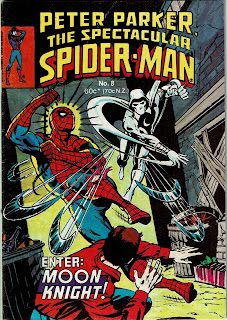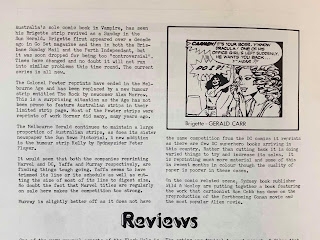When I pick up one of my K.G Murray comics I have a fair idea of when it was published. I can tell by looking at the price, the size and page count, or the logo, whether it was published in the late 1950's, the mid-1960s', the early 1970's, or the early 1980's. If I look closely at it I can often tell the year, and if I'm keen enough to research further, I can often come up with a pretty firm indication of the month it was published.
Not so the Yaffa/Page Publications comics. If I pick up an issue I often can't tell where it fits into the Yaffa schema. Some are regular/magazine-sized, some digest-sized. A series may have both formats. Some issues have an indicia date, which is helpful, and some have an indicia date which is perplexing. Some are reprints of previously published issues and are counted as part of an ongoing series, and some are independent and unnumbered and random. Cover prices change often. And there is no checklist or guide to indicate what a complete catalogue of series, let alone standalone issues may look like.
If you search for Yaffa or Page Publications on this blog you'll find many old entries on issues which I've detailed contents-wise, but have left me scratching my head regarding their publication history. Some of the latter entries have Eureka! moments in which some insight or pattern has emerged, which seems obvious in retrospect but confounding at the time out of context.
So I've taken it upon myself to have a close look at Yaffa's Marvel series - a distinct subset of the Yaffa publishing catalogue - and see what details and patterns and conclusions emerge.
I thought I'd outline in summary form what I have gleaned so far. Most of the information is based on issues in my own collection, which is admittedly far from complete, but I think represents a substantial enough sample size on which to base assumptions and conclusions. I'll leave the supporting details for later posts, but in summary, this is what I have so far:
2. They begin with a $0.50 cover price and 60pp (incl. covers, with some variance)
3. They are a regular/magazine size
4. They increase to $0.60 in early 1978 (typically with #3 if the series began c. October 1977)
5. At this stage they appear to be published on a bi-monthly schedule
6. The 4th issue in the series is published in 1979
7. The first digest-sized issue is published in mid-1980, possibly early 1980 (typically #5 in the series, but there are exceptions eg. Daredevil #5 which is regular/magazine size)
8. The digest issues begin with a $0.60 cover price
9. At this stage the page count still varies but typically they are 60pp
10.The cover price rises to $0.70 on or after August 1981 (typically with #8 or #9 in the series if the series began c. October 1977)
11.This price rise coincides with a change in size from the 'short digest' format to the 'tall digest' format
12. At this stage the page count for most issues is either 52pp or 60pp, with some 68pp issues
13. These issues may have an indicia date 1981, or no indicia date
14. It appears if the indicia date is absent it was published late 1981, or more likely early 1982
15. Indicia dates can be perplexing and manifestly incorrect at this stage of the game
13.After two 'tall digest' issues late 1981/early 1982 the license appears to end and the next phase begins
14.For many series the end is capped by recycling and reprinting the first issue in the series in the original regular/magazine format
15.These issues carry a $1.10 cover price
16.These issues do not have an indicia date
17.These issues appear to have been published early 1982, but possibly even mid-1982
18.The 'short digest' format returns
19.This format is accompanied by another price hike to $0.75
21.These $0.75 issues most likely started mid-1982, possibly early 1982 - on the heels of the $1.10 cover price editions
22.These were published as late as January 1984 and on sale until at least March 1984
23.As per the $1.10 editions the $0.75 issues are unlikely to have a date in the indicia but they do pay lip service to being published under license from the Marvel Comics Group.
23.The Federal Comics Marvel editions were on sale by May 1984, possibly a month earlier.
The above schema is a profile of series which began in late 1977 and had representative editions in all the formats and price changes. It may not apply to every Yaffa series or one-shot. For example, it clearly does not apply to series such as
The Amazing Spider-Man and
Fantastic Four, which have their own particular profile, but is what you can expect from series such as The Avengers, Conan the Barbarian, The Tomb of Dracula etc. It doesn't quite account for non-Marvel Yaffa comics published during this time, nor does it quite account for comics with a $0.65 or $1.00 cover price. And there are exceptions which the above series do not quite model, such as recycled reprints occurring mid-term rather than at the end of a series.
Since I drafted this I've been checking random Yaffa Marvel issues to see whether they conform to this schema and so far so good. There are one or two anomalies but nothing so far to suggest I'm way off-base. Indeed, the anomalies often provide opportunities for fine-tuning rather than exasperation, and I find myself seeking anomalies more keenly than the those inducing confirmation bias. As more issues find their way into the Junkyard, and with the ongoing sharing of data and advice by Mark Cannon and Mark Muller, who contributed quite a bit to my research, and the
AusReprints database, I expect some of the guesstimates of dates to become even clearer over time.
For now, what I think the above information provides for me is a clearer understanding of when the Yaffa/Page Publications editions of Marvel comics were published, especially in reference to the changes signalled by format changes and price changes, which means I now feel much more confident picking up an issue at random and being able to guess which year it was published, and sometimes to also guesstimate whether it was published early in the year, mid-year, or in the last quarter.
Update 21/9/2021:
Here's a pic of a column appearing in The Australian Comic Collector cover-dated June 1980:
The relevant portion says "Yaffa seems to have trimmed its line... cutting the size of most of its line to digest size." Thanks to Jeff Battista for this information.





















































